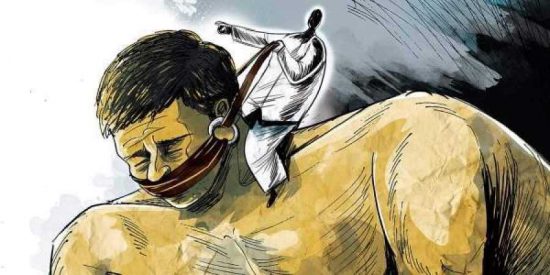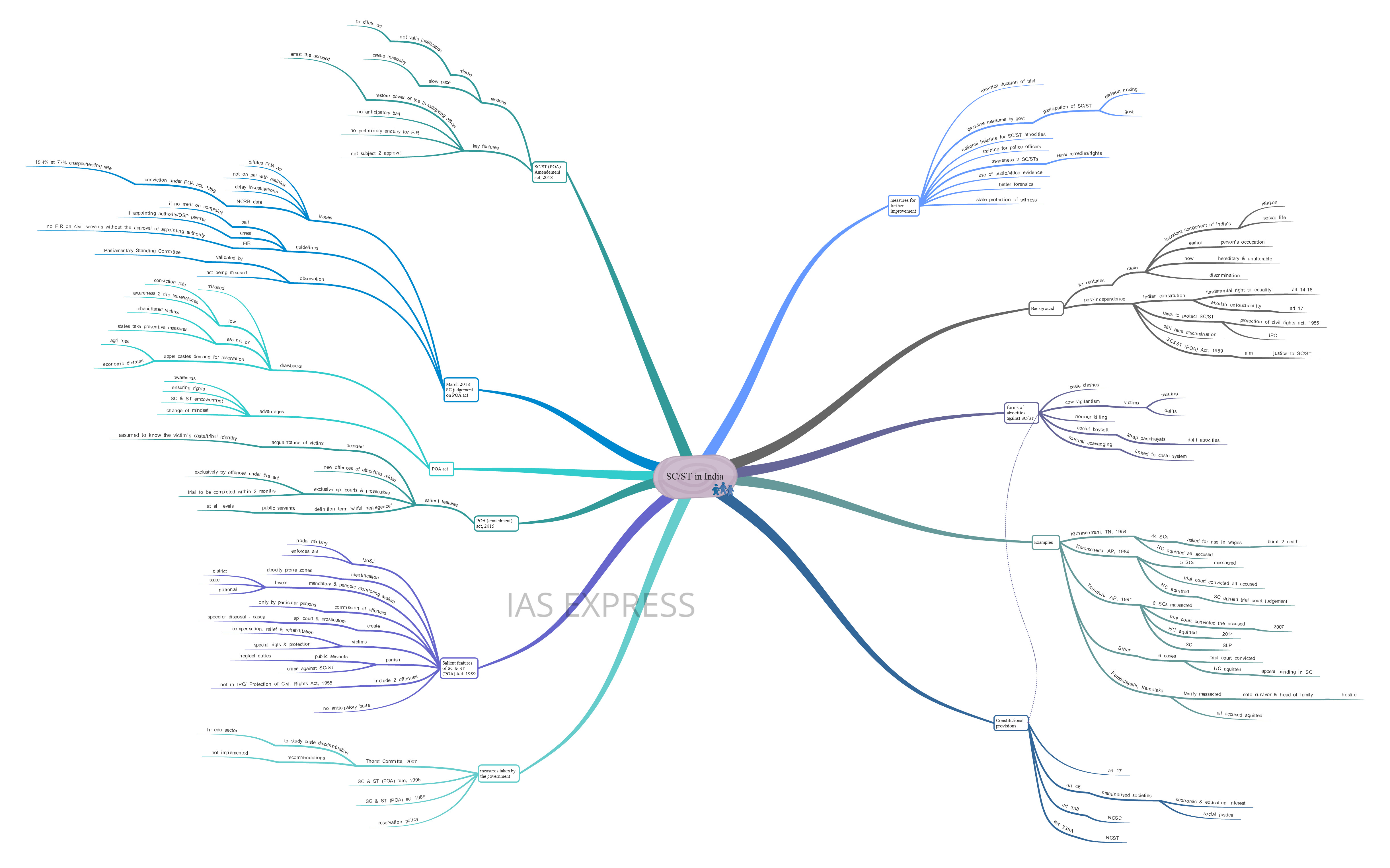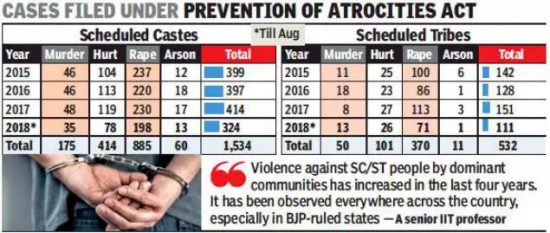SC/ST Prevention of Atrocities Act: Pros and Cons

From Current Affairs Notes for UPSC » Editorials & In-depths » This topic
IAS EXPRESS Vs UPSC Prelims 2024: 80+ questions reflected
The Supreme Court recently criticised the verdict delivered by its two-judge bench in March 2018 that had virtually diluted provisions of arrest under the SC/ST Act and asked whether a judgement could be passed against the spirit of the Constitution.
Indicating that it would make certain orders to “bring-in equality” as per the provisions of law, the top court said people belonging to Scheduled Castes and Scheduled Tribes are subjected to “discrimination” and “untouchability” even after over 70 years of Independence.
Taking a serious view of manual scavenging situation and deaths of SC/ST people engaged in such work, the top court said nowhere in the world people are sent to “gas chambers to die”.
What is the background?
- For centuries, Caste has been the most important component of religious and social life in India.
- The caste of a person was earlier dependent on his occupation, however, it soon became hereditary and unalterable.
- Caste system provided many privileges to the upper castes but allowed repression of the lower caste.
- After independence, the Indian constitution tried to redress the historical injustices and provide an equal platform for the backward sections through fundamental right to equality (Article 14-18) particularly Article 17 which abolishes the practice of untouchability.
- In spite of all these provisions in the constitution and steps taken by the government over the years to improve the social and economic conditions of SCs and STs, they continue to be very marginalized and have to continuously face different forms of crimes, indignities, coercion, and harassment.
- Laws that are meant to protect SCs and STs such as Protection of Civil Rights Act 1955 and the IPC were not able to prevent/stop the atrocities committed against them.
- Recognizing this situation, the Parliament had enacted Scheduled Caste and Scheduled Tribe (Prevention of Atrocities) Act (POA) in 1989.
- The major aim of the POA is to bring justice to SC and ST people through proactive initiatives and empower them to have a dignified and prosperous life.
What are various forms of atrocities against SC/ST?
Caste clashes: There has been an increase in atrocities attributed to the tensions caused between upper castes and Dalits due to the perceived upward mobility of Dalits.
Cow Vigilantism: It refers to the lawlessness happening under the name of cow protection. Dalits and Muslims are at the receiving end of this vigilantism. As Dalits are concentrated in the occupation of leather making from hides of the cow = they are being targeted by vigilantes. Click here to learn more about moral policing/vigilantism in India.
Honour Killing: Honour killing is an extreme form of Moral Policing. Due to the fear of losing the caste status which brings them several benefits, people often commit this heinous crime when their son or daughter marry someone from outside their caste. Click here to learn more about honour killings in India.
Social boycott: Khap panchayat/caste panchayat often acts as an arena for perpetrating atrocities against Dalits by ostracizing them from society. Law Commission drafted the Prohibition of Unlawful Assembly (Interference with the Freedom of Matrimonial Alliances) Bill, 2011 that sought to declare khap panchayats unlawful.
Manual scavenging: Manual scavenging is linked to a caste system where the so-called low castes were expected to perform this job. Notably, there are growing instances of deaths of manual scavengers while cleaning septic tanks and sewage treatment plants in several states of India. Taking a serious view of manual scavenging situation and deaths of SC/ST people engaged in such work, the Supreme Court recently said nowhere in the world people are sent to “gas chambers to die”. Click here to learn more about the plight of manual scavengers in India.
What are some of the examples of atrocities against SCs and STs in independent India?
- Kizhavenmani, Tamil Nadu (1958): in which 44 SCs were burnt to death in a confined building as SC agricultural labourers asked a little raise in their very low wages. The high court acquitted all the accused.
- Karamchedu, Andhra Pradesh (1984):5 SCs were massacred. The trial court convicted several accused persons. But the high court acquitted all. The Supreme Court upheld the trial court judgment – a clear example that acquittals do not mean false cases.
- Tsunduru, Andhra Pradesh (1991):8 SCs were massacred. The trial court convicted the accused in 2007. The high court acquitted them in 2014. The Supreme Court has admitted a special leave petition (SLP) of the surviving victims and survivors of victims.
- Six cases of Biharincluding the Bathani Tola (1996) and Laxmanpur Bathe (1997). In most of these, the trial court convicted the accused. In all of these, the high court acquitted the accused. Appeals are pending in the Supreme Court.
- Kambalapalli, Karnataka: The prime witness in this case, who is the sole survivor and head of the family whose other members were massacred, turned “hostile” due to a threat of life, resulting in the acquittal of all the accused.
What are the constitutional provisions against SC/ST atrocities?
Article 17 of the constitution prohibits the practice of untouchability.
Article 46 promotes the educational and economic interests of SCs, STs, and other weaker sections of the society and protects them from social injustice and exploitation.
Article 338 – National Commission for Scheduled Castes
- investigate and monitor all matters relating to the constitutional and other legal safeguards for the SCs and to evaluate their working.
- inquire into specific complaints with respect to the deprivation of rights and safeguards of the SCs.
338-A – National Commission for Scheduled Tribes
- Its functions are the same as that of NCSC, but with respect to ST instead of SC.
What are the measures taken by the government?
- Reservation policy: The main objective of the reservation system in India is to improve the social and educational status of backward sections and thus improve their standard of living thus preventing any atrocities against them. The reservation that exists today was introduced in 1933 when British Prime Minister Ramsay MacDonald presented the communal award and the resultant Poona Pact. Click here to learn more.
- Due to the ineffectiveness of Protection of the civil right act and Indian penal code, ‘Scheduled Caste and Scheduled Tribe (Prevention of Atrocities) Act’ in 1989 and the Scheduled Castes and the Scheduled Tribes (Prevention of Atrocities) Rules in 1995 came into existence.
- Thorat Committee 2007 – the first-ever committee created for the purpose of studying caste discrimination in the higher education sector. But HRD ministry failed to implement Thorat committee recommendations.
What are the salient features of Scheduled Caste and Scheduled Tribe (Prevention of Atrocities) Act, 1989?
- Creation of new types of offences that are neither present in the Indian Penal Code (IPC) nor in the Protection of Civil Rights Act 1955.
- It punishes crimes against people belonging to Scheduled Castes and Tribes.
- It vests special protections and rights with the victims.
- It creates Special Courts and special public prosecutor for speedier completion of cases.
- Commission of offences only by particular persons (by non-SCs on SCs and non-STs on STs).
- Punishment for public servant (non-SC/ST) in case of neglect of duties.
- Denial of anticipatory bail.
- Gives compensation, relief, and rehabilitation for victims of atrocities or their legal heirs.
- Mandatory and periodic monitoring system at District, State, and National level.
- Identification of atrocity prone zones.
- Ministry of Social Justice is the nodal ministry to enforce the provisions of the Act.
Prevention of Atrocities (Amendment) Act, 2015
The objective is to ensure more stringent provisions for the prevention of Atrocities against Scheduled Castes and the Scheduled Tribes. Salient Features of the amendment Act are as follows:
- New offences of atrocities are added.
- Tonsuring of the head, moustache, or similar acts which are derogatory to the dignity of members.
- Garlanding with chappals or shoes.
- Denying access to irrigation facilities or forest rights.
- Dispose or carry human or animal carcasses, or to dig graves.
- Using or permitting manual scavenging.
- Dedicating a woman as Devadasi.
- Abusing in caste name.
- Perpetrating witchcraft atrocities.
- Imposing social or economic boycott.
- Preventing SC and ST candidates from the filing of nomination to contest elections.
- Hurting an SC/ST woman by removing her from her house, village or residence.
- Defiling objects sacred to members of SC/ST.
- Touching or using words, acts or gestures of a sexual nature against members.
- Creation of Exclusive Special Courts and specification of Exclusive Special Public Prosecutors also, to exclusively try the offences under the PoA Act to facilitate speedy and expeditious disposal of cases.
- Power of Special Courts and Exclusive Special Courts, to take direct cognizance of offence and as far as possible, completion of trial of the case within 2 months, from the date of filing of the charge sheet.
- Clearly defined the term ‘wilful negligence’ of public servants at all levels, starting from the registration of complaint.
- If the accused was acquainted with the victim or his family, the court will assume that the accused has known about the caste or tribal identity of the victim unless proved otherwise.
What are the advantages of the POA Act?
Awareness: The POA has improved awareness regarding different types of atrocities faced by SCs and STs = ensured the reduction in the crime rate because of resultant legal punishment.
Ensuring rights:
- The act has increased awareness among SC/ST about various rights provided by the constitution.
- The act has ensured Right to Equality as guaranteed under the Fundamental Rights of Indian Constitution.
- The act has helped in protecting the unique identity and traditional practices of these communities.
Empowerment:
- POA has improved the political participation of Dalits.
- SCs and STs are now able to avail better education and health facilities without much discrimination.
- The act has helped Dalits economically by increasing access to grants and finances from the government without any discrimination.
- Thus the act has ensured the inclusive development of the Indian economy.
Change in Mindset: The act has created a positive change in the mindset of upper caste towards SCs and STs.
What are the Drawbacks of POA Act?
- Low conviction rate.
- Less number of rehabilitated victims.
- Low awareness among the intended beneficiaries about the different legal remedies and provisions.
- Very few states have implemented preventive measures to stop various atrocities.
- POA act is among the most misused laws in India. Many use this act to settle a personal score or to defame some innocent person.
- There is an ever-increasing demand for reservation among some of the upper castes like Patidars in Gujarat, Marathas in Maharashtra and Jats in Haryana amid agricultural losses and increasing economic distress. But, these demands for reservation are not correct as most of these groups were historically privileged. Click here to read more about reservation in India.
What is the March 2018 Supreme Court judgement on POA act?
Observations:
- In SubhashKashinath Mahajan vs The State of Maharashtra (Review of SC/ST Prevention of Atrocities Act) Case, Supreme Court observed that SC/ST Prevention of Atrocities Act (PoA act) is being misused and measures are needed to prevent such misuse.
- Apex court also observed that the Act has been misused to persecute innocents and public servants for political and personal gains.
- This claim has been validated by Parliamentary Standing Committee report, which has sought an inbuilt provision in the PoA act to safeguard those who are falsely accused.
Key guidelines
- On Bail: The bar on anticipatory bail under the Act need not prevent courts from granting advance bail if there is no merit in a complaint.
- On Arrest: There can be an arrest only if the appointing authority (in the case of public servants) or the district superintendent of police (in the case of others) approves such arrest.
- On FIR: No FIR should be registered against government servants without the approval of the appointing authority.
Issues with the Judgment
- The Supreme Court’s directions to prevent the misuse of PoA act is being perceived by many as a dilution of PoA act.
- Many law experts are of the view that this judgment has not considered the socio-cultural realities of caste atrocities.
- Many critics argue that SC judgment may help to introduce norms to prevent quick action on complaints. It is argued that it will further delay the investigation.
- NCRB data shows that under SC/ST (PoA) Act, 1989 the conviction rate was only 15.4% while the charge sheeting rate is 77%. This indicates that it’s not the misuse of the act but poor implementation of Act which failed to create a deterrence.
- With the perceived upward mobility of SCs, there has been a growing demand among dominant and upper castes to dilute PoA act. This judgment can be used as a tool by these castes to further their agenda.
SC/ST (PoA) Amendment Act of 2018
It restores the original provisions to prevent atrocities against the SCs/STs.
Key features
- It seeks to restore the power of the investigating officer to arrest an accused who is alleged to have committed atrocities against SCs/STs.
- It rules out any provision for anticipatory bail for the accused.
- It provides that no preliminary inquiry will be required for registering a criminal case (FIR) and an arrest under this law would not be subject to any approval.
Reason for amendment
- The alleged potential of misuse should not be considered to be a valid, justifiable or permissible ground for diluting stringent provisions of the PoA (Prevention of Atrocities) Act, 1989.
- In the face of growing atrocities against SCs/STs, aggrieved persons may now think twice before registering a complaint, as the process is backed by checks (by Supreme Court order) which prevent the automatic arrest of an accused.
What needs to be done?
- Minimising the duration of trials.
- SC/ST commission should start a national helpline number for any harassment on the basis of caste.
- Improving the training of police officers in dealing with POA cases so that they can solve the cases without any pressure or prejudice.
- Increasing awareness about several legal remedies and different rights available to the marginalized community.
- Use of audio-video recording to collect evidence.
- Better forensics.
- State Protection of a witness.
- The government should take proactive measures to improve the participation of people from SC/ST community in decision making and government functioning.
The most crucial thing for ending discrimination and improving fraternity is a consistent societal action to change the entrenched caste rigidity. SC/ST Prevention of Atrocities Act (PoA act) only serves as a tool in this endeavour rather than an end in itself.
If you like this post, please share your feedback in the comments section below so that we will upload more posts like this.




I am here just to know how much is the validity of sc and st schemes because now a days at most of the high position in government jobs are ruled by sc and st officers. Now they are having enough money for themselves still they depend on sc/st schemes, . Other caste people’s are lacking behind.. don’t you think now is the time to encourage equality of marks, age and many other things of all castes.